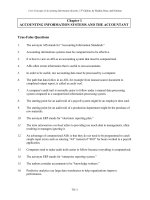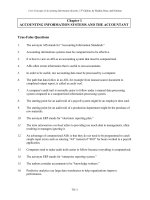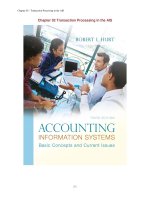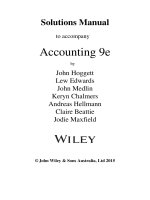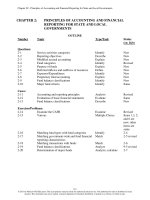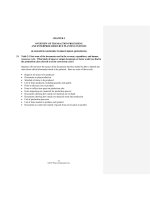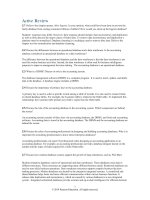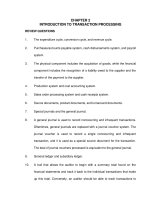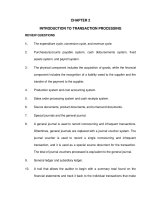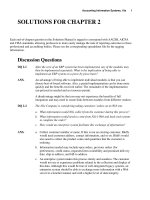Test bank and solution of accounting information systems 3rd (1)
Bạn đang xem bản rút gọn của tài liệu. Xem và tải ngay bản đầy đủ của tài liệu tại đây (427.73 KB, 11 trang )
Chapter 02 - Transaction Processing in the AIS
Chapter 02 Transaction Processing in the AIS
2-1
Chapter 02 - Transaction Processing in the AIS
1. Reading review questions
a. In your own words, explain the similarities and differences between
accounting and bookkeeping. Bookkeeping is the subset of accounting activities
specifically concerned with recording transactions in the AIS, leading eventually to the
production of the four general purpose financial statements. Although both accounting
and bookkeeping require some elements of critical thinking, accounting probably
requires more. In addition, the essential elements of bookkeeping can be mastered in a
much shorter time than the entire body of knowledge in accounting.
b. What systems do accountants use to create and modify a chart of accounts?
In general, most charts of accounts follow a block or hierarchical coding system. In
block coding, similar items are coded similarly; for example, all current assets might
have account numbers that start with “1.” Hierarchical coding is good for more complex
charts of accounts, and is a specialized form of block coding. In hierarchical coding,
groups of digits have meaning. Such a system might be used in a business that has
multiple product lines and / or multiple geographic locations.
c. What internal controls are common in the accounting cycle? Internal controls
useful in completing the accounting cycle include: sequentially numbered documents,
adequate supervision, training & education and separation of duties. In addition, the
requirement that journal entries maintain the equality of debits and credits is also an
internal control.
d. How is human judgment involved in the accounting cycle? Human judgment is
required to recognize recordable transactions. To the extent that the accounting cycle
involves estimates (as with depreciation and bad debts), human judgment is also
important.
e. How has information technology been employed in the accounting cycle?
Information technology is an important component of most modern accounting
information systems; however, the technology is not the system. Common IT tools
employed in the accounting cycle include: general ledger software, spreadsheets,
relational databases and enterprise resource planning systems. Auditors can also use
IT to sample transactions.
2-2
Chapter 02 - Transaction Processing in the AIS
f. List and discuss the six common types of adjusting entries found in most
accounting information systems. Accrued revenues occur when an organization
provides goods or services in one accounting period, but does not bill clients in that
same period. Accrued expenses, on the other hand, occur when an organization incurs
an expense, but does not pay cash until a subsequent period. Prepaid expenses are
assets purchased in one period that are used up over multiple accounting periods, while
deferred revenues involve the receipt of cash in one period for work that will be
performed in a subsequent period. Depreciation and bad debt adjustments both involve
estimates.
g. Explain the purpose and structure of each general-purpose financial
statement. AIS outputs associated with the accounting cycle include four generalpurpose financial statements. The income statement, which includes revenues and
expenses, reports the results of business activity on the accrual basis for a specified
period of time. The statement of shareholders’ equity tracks the changes in both paid-in
capital and retained earnings, also for a period of time. The balance sheet embodies
the accounting equation (assets = liabilities + equity), and reports financial position at a
specified point in time. The statement of cash flows comprises three sections
(operating, investing and financing), and reports the changes in cash for a specified
period of time.
h. In a manner specified by your instructor (e.g., individually or with a group, as a
written paper or as an oral presentation), prepare an original response to one or
more of the questions for this chapter’s “AIS in the Business World.” I was very
fortunate to have three assistants available to prepare responses to the AIS in the
Business World vignettes for the third edition; I’ve posted their responses on my AIS
blog: www.bobhurtais.blogspot.com.
2. Multiple choice review questions. Answers to all of these questions appear at the
end of the textbook itself.
3. Reading review problem
a. Is transaction processing more closely related to accounting or bookkeeping?
Explain your response. Transaction processing is more closely related to
bookkeeping. It follows a strict set of rules and is not subject to much interpretation.
2-3
Chapter 02 - Transaction Processing in the AIS
b. What does it mean to say RKR's chart of accounts is "block coded?" What
other coding systems are available, and when might they be most appropriately
used? Block coding a chart of accounts means that account numbers are assigned
based on the elements of financial statements; for example, current assets might be
denoted by account numbers in the 100s, while plant assets might have account
numbers in the 200s. Hierarchical coding systems are a specialized form of block
coding, in which numbers are grouped together; each group individually is block coded.
Mnemonic codes help users remember the meaning of the code, such as with state
abbreviations. Sequential coding is often used for source documents such as checks
and purchase orders; in that system, items are numbered sequentially.
c. How should RKR maintain strong internal control over its transaction
processing activities? RKR can maintain strong internal control over its transaction
processing activities by enforcing separation of duties (the person who does
recordkeeping should have neither physical custody of assets or authorization for use of
assets. Adequate supervision and training can also be effectively employed to maintain
internal control over transaction processing.
d. Suggest three to five transactions RKR would need to record on a routine
basis. Indicate which accounts would be debited and credited for each
transaction. Purchase of inventory on account: debit inventory, credit accounts
payable. Payment of employee salaries: debit wages expense, credit cash and various
liability accounts for withholding. Sale of meals for cash: debit cash and cost of goods
sold, credit sales and inventory.
.
4. Making choices and exercising judgment
The point of these exercises, which appear in every chapter throughout the third edition,
is to encourage students to think critically and “outside the box.” Thus, I am not
providing solutions to them, as doing so would likely discourage the purpose of these
exercises.
5. Field exercises
Answers to these exercises will vary significantly; thus, like the previous set, I am not
preparing published solutions for them.
2-4
Chapter 02 - Transaction Processing in the AIS
6. Journal entries
a Cash
$
Capital stock
Additional paid-in capital
b Accounts receivable
Sales
c
1,750,000
$
50,000
1,700,000
10,000
10,000
Supplies
Accounts payable
3,000
3,000
d Utility expense
Cash
1,500
1,500
e no entry required
f
Wages expense
Cash
g Equipment
Cash
Notes payable
$
6,000
$
50,000
10,000
40,000
h Cash
Accounts receivable
5,000
i
Accounts payable
Cash
1,400
Interest expense
Interest payable
400
j
6,000
5,000
1,400
400
2-5
Chapter 02 - Transaction Processing in the AIS
7. Adjusting entries.
a Depreciation expense
Accumulated depreciation
b Interest expense
Interest payable
c
Wages expense
Wages payable
$ 1,000
$
100
100
1,000
1,000
d Deferred fees
Sales
300
e Supplies expense
Supplies
650
f
1,000
300
650
no entry
g Bad debt expense
Allowance for bad debts
160
160
2-6
Chapter 02 - Transaction Processing in the AIS
GLP Corporation
Adjusted trial balance
September 30, 20x4
Cash
$
Accounts receivable
Allowance for bad debts
Inventory
Supplies
Equipment
Accumulated depreciation
Accounts payable
Wages payable
Interest payable
Notes payable
Deferred fees
Capital stock
Additional paid-in capital
Retained earnings
Sales
Cost of goods sold
Advertising expense
Wages expense
Interest expense
Depreciation expense
Supplies expense
Bad debt expense
Miscellaneous expense
Totals $
6,000
2,500
$
360
4,500
150
15,000
11,000
1,200
1,000
100
6,000
600
7,000
8,000
11,000
16,300
13,500
5,000
13,000
100
1,000
650
160
1,000
62,560
$
2-7
62,560
Chapter 02 - Transaction Processing in the AIS
8. Financial statements.
GLP Corporation
Income statement
For the quarter ended September 30, 20x4
Sales
Cost of goods sold
Gross profit
$
$
Expenses:
Advertising expense
$
5,000
Wages expense
13,000
Interest expense
100
Depreciation expense
1,000
Supplies expense
650
Bad debt expense
160
Miscellaneous expense
1,000
Net loss
20,910
$
2-8
16,300
13,500
2,800
(18,110)
Chapter 02 - Transaction Processing in the AIS
GLP Corporation
Balance sheet
As of September 30, 20x4
Assets
Cash
Accounts receivable (net)
Inventory
Supplies
Equipment (net)
Total assets
Liabilities & equity
Accounts payable
Wages payable
Interest payable
Notes payable
Deferred fees
$
$
Capital stock
$
Additional paid-in capital
Retained earnings (deficit)
1,200
1,000
100
6,000
600
$
6,000
2,140
4,500
150
4,000
16,790
$
8,900
7,000
8,000
(7,110)
Total liabilities & equity
7,890
$
9. Coding systems
a. mnemonic
b. sequential
c. sequential
d. hierarchical
e. sequential
f. hierarchical
g. block
h. block
i. block
j. block
2-9
16,790
Chapter 02 - Transaction Processing in the AIS
10. Terminology
1. F
2. D
3. C
4. B
5. I
6. G
7. A
8. H
9. E
10. J
11. Multiple choice questions
1. B
2. A
3. C
4. B
5. D
12. Statement evaluation
a. never true
b. sometimes true. The adjusting entry for an accrued liability is an example.
c. always true
d. sometimes true. The complexity of the chart of accounts will help determine
which system to use.
e. never true
f. sometimes true. The statement describes an accrued revenue adjustment; the
term “accrual” could also be used for an accrued expense.
g. never true
h. always true
i. sometimes true. Block coding facilitates closing entries, but not all automated
AIS use block coding.
j. always true
2-10
Chapter 02 - Transaction Processing in the AIS
13. International Financial Reporting Standards
a. Compare and contrast the IFRS framework with the FASB Conceptual
Framework discussed in Chapter 1. List three similarities and three differences
between the two. Similarities include (but are not limited to): Both frameworks were
developed by a standards board (FASB and IASB). The structure of the two
frameworks is similar. They both include some common elements, such as objectives
of financial statements/ financial reporting and elements of financial statements. On the
other hand, the frameworks differ in the following ways: The qualitative characteristics
are different between the two frameworks. The IFRS framework identifies five elements
of financial statements; the FASB framework, eight. The IFRS framework includes a
section titled “Concepts of Capital and Capital Maintenance,” but the FASB framework
does not.
b. Choose two countries that have adopted IFRS. If an organization had
operations in both countries, how would you communicate that fact in their chart
of accounts? A list of countries that have adopted IFRS is available at
To communicate multi-national operations
via a chart of accounts, you could use a hierarchical code that includes a mnemonic
abbreviation for the country. For example, if Cash is account #101, DEN101 could
denote Cash in the Denmark branch and AUS101 could denote Cash in the Australian
branch. Other systems are definitely possible as well.
2-11
